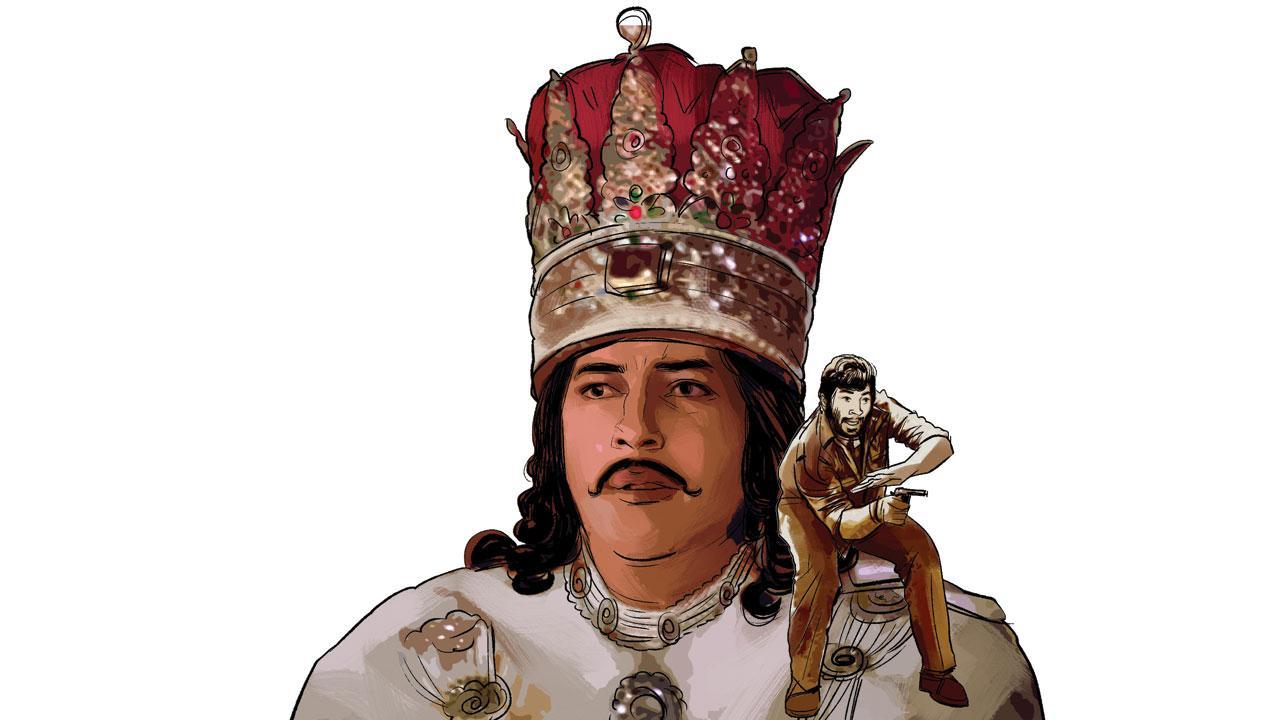He describes the ‘70s decade as “a post-golden but pre-rotten period, when poetry, music and cinema were still full of joy and insights”

Illustration/Uday Mohite
![]() There are many delicious, insightful, as well as laugh-out loud moments in the book The Swinging ‘70s: Stars, Style and Substance in Hindi Cinema, edited by Nirupama Kotru and Shantanu Ray Chaudhuri (Om Books International, 570 pages, Rs 475-695). The book was launched with a panel featuring filmmakers-contributors Sriram Raghavan and Varun Grover, along with editor Nirupama Kotru, organised by Avid Learning, led by Asad Lalljee, along with the Asia Society India Centre, led by Inakshi Sobti, at the Royal Opera House, Mumbai, last week. Kotru, earlier Director (Films) in the Ministry of Information and Broadcasting, has been a film writer since 2015; Chaudhuri is Editor in Chief, Om Books International and writer, of course.
There are many delicious, insightful, as well as laugh-out loud moments in the book The Swinging ‘70s: Stars, Style and Substance in Hindi Cinema, edited by Nirupama Kotru and Shantanu Ray Chaudhuri (Om Books International, 570 pages, Rs 475-695). The book was launched with a panel featuring filmmakers-contributors Sriram Raghavan and Varun Grover, along with editor Nirupama Kotru, organised by Avid Learning, led by Asad Lalljee, along with the Asia Society India Centre, led by Inakshi Sobti, at the Royal Opera House, Mumbai, last week. Kotru, earlier Director (Films) in the Ministry of Information and Broadcasting, has been a film writer since 2015; Chaudhuri is Editor in Chief, Om Books International and writer, of course.
The book proposes that the 1970s were the most influential decade of Hindi cinema: its essays analyse the big stars, the art and craft of filmmaking, music, fashion trends, and the coexistence of commercial blockbusters, parallel cinema andindependent arthouse classics, including Ramesh Sippy’s Sholay and Satyajit Ray’s Shatranj ke Khilari, with Amjad Khan starring in both. It’s a fat tome, with essays by a huge roster of over 40 writers—filmmakers including Sriram Raghavan, Vishal Bhardwaj and writer-director-stand-up comedian Varun Grover, writers including Amitava Kumar, senior critic-scholars including Amrit Gangar and Maithili Rao, and a host of other critics, such as Aseem Chhabra. It covers vast ground, and one is tempted to binge-read; but it is more rewarding to read, pause and savour. The book includes a number of colour and b/w posters and stills of films of the decade.
Sriram Raghavan offers us Guilty Pleasures: the Masala Entertainers of the Seventies, a nostalgic, laugh-out loud essay, on the joys of mainstream films that rarely made it to any Top Ten lists, that he watched in Poona: “the single screen cinemas with their crowded cycle stands, garlanded houseful boards and black-marketing aunties, who would pull out tightly folded tickets from one bosom and stuff your money in the other, are a thing of the past.” His guilty pleasures include (the original) Agent Vinod, whose title he borrowed and whose character he reinvented (the original had Bond tropes with gadgets, “including a coat that fired from the armpits when the owner is asked to ‘Hands Up’!), and The Train (“It’s got Meri jaan maine kaha, one of the greatest RD Burman scores ever”), so, of course, you jump onto Youtube to check out the song, a flamboyant Helen number.
Lyricists of the ‘70s, both well-known and overlooked, feature in Varun Grover’s essay, including Kaifi Azmi, Shaily Shailendra, Shahryar, Santosh Anand and Yogesh Sa’ab. He describes the ‘70s decade as “a post-golden but pre-rotten period, when poetry, music and cinema were still full of joy and insights.”
Amitava Kumar contributes an essay on Shyam Benegal’s Nishant, on the abduction of a schoolteacher’s wife by feudal landlords, that provokes an uprising against them. We learn the amazing fact that writer-playwright Vijay Tendulkar, who wrote the screenplay, had travelled all over India on a Nehru Fellowship in 1972-73, meeting tribals, convicts, etc to research ‘Emerging Patterns of Violence and its Impact on Literature,’ that considerably enriched his writing. Senior critic-scholars Amrit Gangar and Maithili Rao, both also my mentors, contribute thoughtful essays on the parallel cinema movement. Rao shines a light on its landmarks, including Mani Kaul’s Uski Roti and Kumar Shahani’s Maya Darpan, while Gangar analyses their films’ form, lensing, colour concepts and philosophy, describing them as ‘filmosophers’.
There are also delights like the hysterically funny essay by Krishna Shastri Devulapalli, North by South East, on the joys and horrors of Telugu/Hindi/Hollywood cinema, with witty observations on mind-boggling Telugu to Hindi remakes and Hindi to Telugu remakes. I’ll leave you with his description of the ‘post-coital cigarette’ in Deewaar’s Telugu remake, Magaadu by KSR Das: “NTR, lying next to Manjula (filling in for Bachchan and Babi respectively)… NTR’s casual inhalation, using a reverse shot, of the exhaled cloud of smoke from Manjula’s cigarette—is the kind of thing one takes to the afterlife.” He recommends watching these Hindi-to-Telugu and Telugu-to-Hindi remakes of the ‘70s and early ‘80s alternately. “Contact me for a curated list,” he offers. We intend to take him up on his offer forthwith.
Meenakshi Shedde is India and South Asia Delegate to the Berlin International Film Festival, National Award-winning critic, curator to festivals worldwide and journalist.
Reach her at meenakshi.shedde@mid-day.com
 Subscribe today by clicking the link and stay updated with the latest news!" Click here!
Subscribe today by clicking the link and stay updated with the latest news!" Click here!








